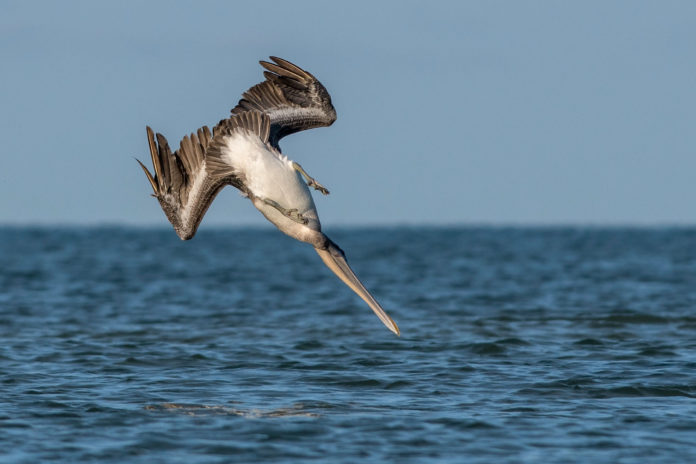Imagine a line of big pelicans flying just above the breaking surf of the coast with the Hunting Island lighthouse and the treetops of the maritime forest in the background. That’s life at the beach.
A day at the beach any time of the year usually provides ample opportunity to see them.
Perhaps you’ve watched, or heard, pelicans fishing in the ocean. It can be a sight to see. The big birds, which have a wingspan reaching just over six feet, soar up above the water looking for fish. When they spot their prey, they turn into a shooting arrow with their sharp bill aimed straight for the water. At high speed, they smack into the surface of the sea and scoop up their prey.
Doesn’t that hurt?
Anyone who has taken a belly flop off a diving board knows the powerful force of hitting the water.
According to an article by the National Audubon Society, several adaptations protect pelicans as they dive, sometimes from as high as 60 feet or more.
Air sacs beneath the skin on their breasts act like cushions. Also, while diving, a pelican rotates its body ever so slightly to the left. This rotation helps avoid injury to the esophagus and trachea, which are located on the right side of the bird’s neck.
Pelicans have also learned that a steep dive angle, between 60 and 90 degrees, reduces aiming errors caused by water surface refraction. We know that pelicans ‘learn’ this behavior as they age and gain experience because adults are better marksmen than younger birds.
Upon impact, pelicans open their bills and expand their pouches, trapping small fish inside. Then the bird pops to the surface, spills out the water, and gulps down dinner.
Pelicans perfected the art of this fishing technique about 30 million years ago, and it hasn’t changed much since.
According to the SCDNR, the eastern brown pelican was listed as an endangered species in 1970, when their population plummeted to less than 100. They were removed from the endangered species list in 2009, and are now thriving.
To see such a large bird dive bomb into the water is surprising. But even more so is the fact that they can do so without breaking their necks.










